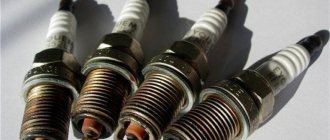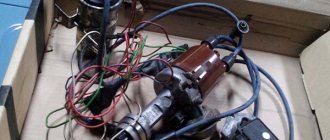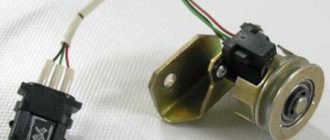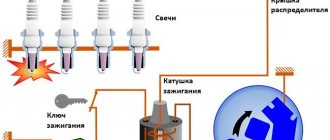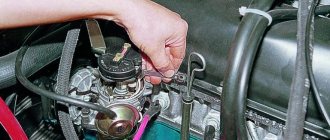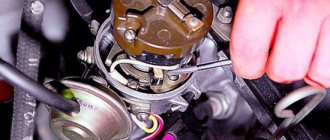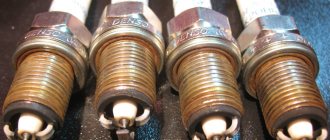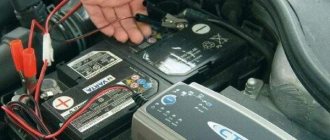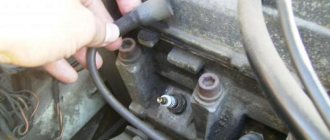If, when there are interruptions in operation, impossibility of starting, etc., of the UAZ-469B engine, there is a suspicion of a malfunction of the ignition system, then, first of all, it is necessary to check the presence of a spark in the spark plugs.
At the same time, if between the spark plug wires and the engine housing and the high voltage wire of the ignition coil and the housing, a spark breaks through a spark gap of 6-7 mm without interruption, then the ignition system is working.
Checking the operation of the ignition system on the UAZ-469B.
If there is no spark between the high voltage wire of the ignition coil and the housing, you need to check the low voltage circuit between the battery and the ignition coil. This can be done with a portable lamp, using it as a control lamp.
If, when switched on between terminal VK-B of the ignition coil and the car body, the light comes on when the ignition is on, then the low voltage circuit is operational. If the light does not light up, you need to check the ignition switch, ammeter and wiring by connecting one wire of the test lamp in series to the ammeter terminals and the AM and KZ terminals of the ignition switch, leaving the second contact of the light bulb connected to the car body.
If the low voltage circuit between the battery and the ignition coil is working, damage should be looked for in the wires connecting the breaker lever with a contact isolated from the breaker body and the movable and fixed panels in the distributor. Breakage of these wires, as a rule, occurs after prolonged use. This malfunction can be identified using the same portable lamp.
To do this, you need to connect one of the legs of the portable lamp plug with a separate wire to the low voltage terminal on the distributor, and the second leg to the car body. Then turn on the ignition and, turning the crankshaft with the starting handle, observe the lamp. When the contacts are opened, the lamp should light up and vice versa. If the lamp does not go out when the contacts are closed, this confirms a break in one of the indicated wires. In this case, it is necessary to remove the distributor from the engine and eliminate the malfunction.
If the low voltage circuit turns out to be serviceable, it is necessary to check the condition of the breaker contacts and, if there is a malfunction, eliminate it. Interruptions in the operation of all spark plugs of the UAZ-469B engine can be caused by wear on the edges of the breaker cam, a reduced or increased gap between the breaker contacts. As well as a break in the wire connecting the movable and stationary plates of the breaker, short circuit of the primary or secondary windings of the ignition coil, a crack in the distributor cap, wear of the distributor cap carbon and a decrease in the capacitance of the capacitor.
Interruptions in engine operation at high crankshaft speeds may be the result of low pressure on the breaker contacts, which is provided by the spring of the moving contact lever. When the tension of the breaker spring is weakened, the force is less than 500 gf, vibration of the contacts occurs, which leads to interruptions in the operation of the ignition system.
If the spark is weak on all spark plugs, then it is necessary to check the fastening of the capacitor to the distributor body. In addition, a weak spark on the spark plugs may occur if, when starting the engine, the starter does not turn off the additional resistor of the ignition coil. This usually occurs as a result of oxidation of the contacts of the starter switch and slip ring.
Checking the technical condition of the UAZ-469B ignition system devices and their repair.
Checking the technical condition and repairing the B7-A ignition coil and additional resistor.
Ignition coil malfunctions include insulation breakdowns and turn-to-turn short circuits of the primary and secondary windings, breaks in the winding wires from the output terminals, cracks in the cover, as well as burnout of the additional resistor.
If the insulation of the windings breaks down, the engine stops and cannot be started. When interturn short circuits and breaks in the wires of the windings from the output terminals occur, interruptions in the operation of the engine occur. When the additional resistor burns out, the engine starts easily with the starter, but when the starter is turned off, it stops immediately.
Since when the starter is turned off, the engine can stop even if the ignition switch is faulty, you need to make sure that after turning off the starter, current is supplied to the VK-B terminal of the ignition coil. A characteristic sign of damage to the additional resistor is also normal sparking when cranking the engine with the starter and the absence of a spark when cranking it with the starting handle.
A burnt-out additional resistor must be replaced. If there is no spare resistor, it can be made from nickel wire NP-2 GOST 2179-59 with a diameter of 0.3 and a length of 740 mm. If the additional resistor comes off at the place where its ends are attached, then it must be soldered using acid-free soldering.
UAZ loaf no spark from the ignition coil
I decided to name the topic just like that “No spark after the distributor” because I didn’t find anything on the entire Internet for such a request, please do not delete it to the admins, please maybe someone will find my experience useful.
And so the story itself, in the middle of the city, the car stopped starting and they pushed and towed, it still won’t start, they checked the spark on the spark plug, there is no spark, they decided to check if there is a spark on the central cable after the coil, there is a fat white spark, they changed the distributor, still no spark, they changed the slider, spark We arrived at the meeting, the car still won’t start, the starter turns like crazy, still nothing, we check the switch, there is no power, there was one dead swollen capacitor in the switch, replaced no, the car started.
Solution to the problem: I replaced the coil, the spark became fat and blue and this is the main thing.
The situation when a car does not want to start, although quite common, is still very unpleasant. Especially considering the fact that it always happens precisely at the time when we are in a hurry to get somewhere. There are many reasons why the engine does not want to work, but the most common of them is due to the fact that there is no spark from the ignition coil.
Methods for checking an injection and carburetor engine in the absence of a spark
If there is no spark on the engine, different diagnostic methods are used:
- checking for ground;
- checking with a digital multimeter (tester);
- using a special tester with a piezoelectric element.
It is recommended to use the ground test only on vehicles with a carburetor. To do this, you need to take a spark plug and bring it to any metal part of the engine (the cylinder block is good). Another person in the cabin should try to start the engine by turning the key in the ignition. This determines the supply of a spark to a specific spark plug.
Important! It is not advisable to use this method to check the spark on injection machines, since they use expensive electrical equipment that can fail due to such “diagnostics”. Using a multimeter allows you to check the spark plugs themselves
The diagnostic principle does not differ from the first method, but the likelihood of damage to the engine ECU is minimized. A special device called a “discharger” allows you to check the spark on a carburetor engine. Using such a device, you can easily determine in which segment of the car’s ignition system there are problems.
Using a multimeter allows you to check the spark plugs themselves. The diagnostic principle does not differ from the first method, but the likelihood of damage to the engine ECU is minimized. A special device called a “discharger” allows you to check the spark on a carburetor engine. Using such a device, you can easily determine in which segment of the car's ignition system there are problems.
If there is no spark in all cylinders, the culprit may be the controller, ignition coil/module, or center wire. First you need to check the condition of the fuses. After this, we check the ground connection and high-voltage wires.
If there is no spark at the coil, you need to check the condition of the central high voltage wire. The presence of damage to the insulating layer, breakdowns and other defects is unacceptable. If they are found, this element must be replaced.
In addition, while searching for a spark, do not forget to check the spark plugs. But it is advisable to do this only after you have reliably established that the spark definitely reaches the spark plugs. The check is performed using the method mentioned above. The spark should be white with a slightly bluish tint. If there is a spark, but it is weak, check the condition of the spark plug contacts. In any case, replacing spark plugs is inexpensive, so it won’t be superfluous.
Why does the coil not produce a spark?
Among the reasons that the vehicle does not want to start are:
- fuel does not flow to the carburetor;
- no spark from the coil;
- the current signal does not reach the coil;
- the ignition distributor is broken;
- there is no spark between the spark plug electrodes;
- no current flows to the toggle switch.
In addition, sometimes it happens that the operation of the power unit is blocked by the starter. But, first of all, you should inspect the winding of the electric motor. Perhaps there are cliffs there. If not, then, for the most part, the starter will be fine. In this case, you should inspect the coil.
How to understand that there is no spark from the ignition coil
First of all, you need to understand what this node is all about. In fact, this device is designed to convert current from low to high voltage. Without the normal operation of the system, the operation of the vehicle is impossible at all . You can understand that there are some problems with such an element by the following characteristic symptoms:
- the power of the power unit has decreased;
- there are certain problems with starting the engine;
- fuel consumption has increased;
- There are interruptions in the operation of the vehicle at idle speed.
How to check spark on ignition coil
When you realize that the problem lies in the coil, you should repair it. But you shouldn’t immediately run to the service center if there is no spark from the ignition coil. After all, you will have to pay a lot for such services.
First you need to conduct a visual inspection of the element. Various deformations, mechanical damage, severe dirt and stains can lead to no current flowing to the ignition coil. Dirt must be wiped off with a dry cloth. You also need to pay attention to the wiring.
It is important that there is no moisture or breaks on it.
Then you should move the high-voltage wiring a little. If after this there is still no spark from the ignition coil, then it is necessary to engage in more thorough diagnostics.
About the purpose of the coil
Symptoms of a faulty ignition coil.
When this is the problem. To ignite the combustible mixture of gasoline and air compressed in the working area of the cylinder, a high voltage is required on the spark plug. Its value exceeds 30 thousand volts. The on-board voltage of the car in most cases is 12 Volts. The ignition coil is designed to obtain the required value.
Photo of ignition coil VAZ 2101-2107
This component of the car must be given due attention; if other systems fail, the car can independently reach the parking lot or service center. In the case where there is no spark, this is impossible to do.
You will have to look for a tow truck or call a tow truck.
Checking the spark plugs and coil
Next, it is necessary to evaluate the adequacy of the functioning of the candles. First of all, remove 2 high voltage wires from the distributor. Then we place the wiring so that it is 7 millimeters from the motor. We start the starter. If you see a blue spark, the system is working properly. If the shade is different, or there is no spark at all, it is necessary to repair the system.
Then, in a situation where you have lost the spark from the ignition coil, you need to evaluate the performance of the coil itself. The algorithm here is no different from checking candles. We take the wire that comes from the coil, and then bring it to the motor. If there is no spark when starting the engine, then the element is faulty.
But the work doesn't end there. Now you should take an ohmmeter. This way it will be possible to detect a break in the circuit. If everything is normal, then, checking the primary winding, we will see 3 Ohms, and the secondary - 7000 Ohms . If the indicators we obtain are below standard values, you should purchase a new coil.
If there is no spark from the ignition coil, you should very carefully check all the wiring and contacts. Inspect the wiring insulation; there is a possibility that there is a certain defect. First of all, it is necessary to untangle the wiring and also lay it out correctly. Then we take an ammeter. To check the system with it, you should connect the wiring of the distributor, and then turn on the ignition.
It is important that the resulting current reading does not exceed the permissible limit for your vehicle.
If the current is more than needed, this indicates a break that occurs in the event of a short circuit. As a rule, such a problem occurs when the ignition is turned on while the engine is off, which leads to a break in the high-voltage wires.
Operating principle of the ignition system
Ensuring that the fuel-air mixture ignites at the correct time for efficient operation of an internal combustion engine is the primary task of ignition. This occurs in strict accordance with the predetermined operating sequence of the engine cylinders. The ignition coil 16 is connected in series with an additional resistor 14 in an electrical circuit. It closes automatically when the engine is started by the starter.
This leads to a significant increase in the breakdown current of the primary circuit. Ignition coil 16 generates high-frequency pulses in the vehicle's on-board electrical system. Flashes of high voltage interrupt the spark on the spark plugs 12, screwed into the top of each cylinder, where the working fuel mixture is compressed.
The coil consists of a primary winding and a secondary winding. The primary winding is wound onto the secondary. This is how the UAZ 469 ignition system works. Inside the coil there is a core and a ring magnetic circuit. Both of these components are made of special electrical steel. The reel is closed with a carbonite cover in a housing with a rubber seal.
Transformer oil is poured into the cover for cooling. This material significantly increases the winding insulation and effectively removes heat from the coil body. To avoid damage to the coil and overheating, it is not recommended to leave the ignition on when the engine is off.
Distributor 8 distributes high-voltage pulses to all cylinders of the internal combustion engine strictly sequentially. The distributor or breaker-distributor is installed in a standard location on the left side of the engine cylinder block. This mechanism is driven by the oil pump shaft. From the cover side, the shaft rotates counterclockwise.
What kind of ignition system is there for UAZ 469?
Contact ignition on the UAZ 469, which is now considered obsolete. However, domestic manufacturers still use it. The system delivers a pulse of a certain power. This pulse appears in the ignition distributor. The contact ignition circuit of the UAZ 469 is simple and straightforward. This is its advantage. The driver can fix any malfunction and make adjustments with his own hands. Prices for components are low.
Transistor or contactless ignition system in the UAZ 469. The contactless ignition system is installed on many types of cars. It has a number of advantages compared to the contact design. The spark created by such a device is much stronger. This occurs due to an increased level of electrical voltage in the secondary winding of the ignition coil. The transistor ignition system is equipped with an electromagnetic mechanism. It ensures stable, continuous operation of the entire system, smoothly transferring energy to components, parts and mechanisms. Correctly adjusted ignition with a working internal combustion engine guarantees high power and significant fuel savings. Long-lasting and reliable operation is ensured by following the drum motor's maintenance intervals. It should be lubricated and adjusted every 10,000 km. The disadvantage of a contactless ignition system is the difficulty of repair. It cannot be repaired yourself, since this requires specialized diagnostic equipment, available only at service centers and stations.
Electronic ignition system of the UAZ 469. This type of ignition is the most technologically advanced, but at the same time it is not cheap. Modern car models are equipped with such devices. It has advanced technology that provides not only high torque, but also a number of other engine parameters. Advantages: easy adjustment of the advance angle, no need to check contacts for oxidation. In engines equipped with electronic power take-off, the fuel mixture burns up to 100%. Repairs may only be carried out at a service station.
Underwater ignition on the UAZ 469 This is a sealed ignition system that is not afraid of being flooded with water, falling into deep holes, or driving in the open air during snow and rain. With normal ignition - contact or non-contact - 50% of the spark power is lost inside the barrel, between the cap and the guide. Let's find out why this happens.
There is a small space between the electrical contacts, which are the distributor cap and the guide. The flow of electricity in this space absorbs most of the additional current. In the case of contact ignition, an additional part of the energy is spent for this purpose due to the operation of the cam.
The underwater ignition is designed in such a way that the spark from the coil goes directly to the spark plug. During this process, it does not lose its main power, except for the resistance of the high-voltage wires. The power losses here are very small, so they can be neglected.
It is worth noting that in most foreign-made cars, a coil is installed separately for each cylinder, which is located directly on the spark plug, and the losses, accordingly, are quite insignificant.
What to do next
So, the reason why there is no spark from the coil has been discovered. Now we need to decide what to do next. There are two main options:
- repair the faulty element;
- purchase a new coil, and then replace it.
Repairing a unit is a rather complex process. Here it is necessary to disassemble the mechanism into its component elements, then check them for various chips, scratches and other defects, and then clean up the damage. Then you need to restore the shell using glue or a special composition.
To replace the coil, you need to select a model with similar parameters.
It is important to connect the connecting wires correctly, otherwise there is a high risk of overheating and a short circuit. If a spark appears during the test, and the data obtained by the ohmmeter and ammeter are within normal limits, then you should look for a problem in the remaining elements of the ignition system.
To summarize, we can say that several elements are responsible for starting a car engine. At the same time, the main reason here is that there is no spark from the ignition coil. Before solving this problem, it is necessary to understand why exactly this situation arose. You should carefully check the spark plugs, wiring and the coil itself. Having discovered where exactly the problem lies, it is necessary to replace or repair the faulty element. On the other hand, it requires special equipment and instruments, so if you don’t have all this, you should entrust repairs and diagnostics to the hands of professionals .
Magneto ignition coil. Checking serviceability and setting the gap.
We often encounter situations where tool users come in with a faulty ignition.
Often it actually turns out to be faulty, but often the ignition coil has nothing to do with the breakdown of the tool. The steps to check the serviceability of the ignition coil are described below. Assessment of the current state of the coil.
Before working on the ignition coil, it is worth checking the serviceability of the entire circuit. Do the following:
- visually assess the absence of cracks and visible defects on the reel body
- contamination of conductive elements and components
- serviceability and insulation of high-voltage wires, wire contacts, reliability of their fastening, absence of rust at fastening points
- check the condition of the spark plug cap: it is often torn off from the high-voltage wire and tried to be restored using “improvised” methods. Remember: any “snot” in this place reduces the quality of the electric arc of the spark plug
- check the serviceability of the spark plug. The quality of our gasoline does not allow the spark plug to “live long”
- Check that the circuit breaker is working properly. This is especially true for Chinese saws and trimmers.
The point of these actions is to exclude from the list of possible faults all circuit elements except the coil. If everything is ok, we move on.
Troubleshooting the ignition system
Malfunctions of the car’s ignition system are unpleasant because any of them is always accompanied by serious interruptions in the engine’s operation or its complete stop. The main sign of a malfunctioning ignition system is the complete absence or “weak” spark between the electrodes of the spark plugs. What to do if there is no spark, and where to look for it? Read about this and more in our material.
Most often, the spark disappears precisely at the moment when you need to go somewhere. In order not to push the car to the nearest car service center, it is important to understand what the operation of the ignition system depends on, then finding the missing spark will not cause any particular difficulties.
At the end of this article, watch the video instructions for finding a spark in the ignition system of VAZ cars.
And below we propose to get acquainted with the algorithm for searching for a missing spark in a car’s ignition system.
Chain lubrication system
If there is a significant (small is considered normal) oil leakage, you need to check the tightness of connecting the tubes to the pump fittings. They may fall off or crack. Violation of the tightness of the oil line, in addition to drips, can also lead to insufficient lubrication of the chain. The pump begins to suck in air, which affects its performance. No spark on chainsaw | video in Zaporozhye. Violation of the tightness is eliminated by replacing the tubes or sealing them with sealant.
The most serious failure of the lubrication system is cracks in the oil pump housing. In this case, it will have to be replaced.
Why is there no spark at the spark plugs?
There can be several reasons for the lack of spark at the spark plugs. Most often the culprits of the malfunction are:
- Accumulator battery;
- High voltage wires;
- Ignition coil;
- Distributor;
- Malfunctions in the low voltage circuit.
Also, in the absence of a spark, special attention should be paid to checking the quality of contacts and electrical connections of the ignition system elements. You can check the condition of the contacts simply by rubbing them with your hand.
Carefully inspect the wires and blocks of the ignition system - if dirt, oil or water is found on them, they must be wiped with a dry cloth. After that, try starting the engine, it may start this time.
Checking the battery
A clear sign of problems with the battery is a dull and quiet horn signal. Also, if there are problems with the battery, the indicator lights on the instrument panel usually go out while the starter is rotating. In this case, the reason for the lack of a spark may be poor contact at the terminals or a low battery charge.
- If the terminals are oxidized, they must be cleaned and tightened tightly. In addition, you can use graphite lubricant, which will reliably protect the contacts from oxidation in the future.
- If the battery is discharged, it must be charged using a charger.
For information on how to properly charge a car battery and maintain it, read our battery charging instructions.
Checking high voltage wires
Next, it’s worth inspecting the high-voltage wires: they must have a neat, not “tattered” appearance, without insulation damage, otherwise they will have to be replaced. If the wires are ok, then you can start looking for a spark.
We recommend starting your search for a spark with the spark plug wires. To do this, you need to remove the tip of the spark plug wire from the spark plug and bring it to the “ground” (the nearest unpainted metal part of the body or engine) at a distance of 5-8 mm, after which you need to turn on the starter for a few seconds.
The rotation of the starter should be accompanied by an uninterrupted bright spark of white color with a slight blue tint. If there is no spark, you need to check the ignition coil. A violet, red or yellow spark indicates a malfunction in the ignition system.
It is also worth noting that the spark plugs themselves rarely fail all at the same time. If there is a “spark” in the spark plug wires, you can check any spark plug by unscrewing it from the cylinder head and putting the spark plug wire on it. Touch the metal part of the spark plug to the “ground” of the car, and by rotating the starter, make sure that there is a spark at the electrodes of the spark plug.
It is necessary to change spark plugs within the time limits established by the maintenance regulations for your car (usually every 15-25 thousand km).
You can learn more about the markings and heat ratings of spark plugs from our material at this link.
Checking the ignition coil
To check the ignition coil, you need to pull out the central wire coming from the coil from the distributor-breaker cover.
While turning the starter, make sure there is a spark from the wire, similar to the spark plug wires.
- The appearance of a spark indicates the serviceability of the ignition coil. In this case, the fault should be sought in the distribution switch.
- If there is no spark from the wire, then the cause of the malfunction is hidden either in the ignition coil or in the low voltage circuit.
If there is a malfunction in the ignition coil, it should be replaced with a new one.
Checking the ignition distributor
If you suspect a malfunction of the breaker-distributor, you must carefully inspect its cover from the inside.
- If the cap is in order, then simply wash it with gasoline,
- If any cracks are found, the cover will need to be replaced.
The center carbon contact of the breaker is checked for sticking by lightly moving it with your finger.
The rotor insulation of the breaker-distributor is checked for breakdown as follows:
- Place the central high-voltage wire with a gap of 5-8 mm from the rotor electrode,
- After this, close and open the breaker contacts with your hand (the ignition must be turned on).
The appearance of sparks in the gap indicates a rotor malfunction that will need to be replaced.
Low Voltage Circuit Test
To check the low voltage circuit, you can use a 12 V test lamp with a power of up to 3 W. The lamp is connected on one side to the low voltage terminal of the breaker, and on the other to the vehicle ground.
After this, you need to manually close the contacts of the distributor-breaker and turn on the ignition. If the low voltage circuit is working properly, the control lamp should light up when the contacts open, and go out when they close.
If the lamp does not light up when the contacts are opened, it means that the fault is hidden either in the low voltage wires or in the primary winding of the ignition coil.
Constant lighting of the lamp, in any position of the contacts, indicates one of three causes of the malfunction:
- Severe oxidation of breaker contacts;
- Broken wiring leading from the breaker terminal to the lever;
- Broken wiring connecting the movable disk of the breaker to the housing.
If the cause of the malfunction turns out to be oxidized contacts, then they must be cleaned, after which the gap should be adjusted.
Site about off-road vehicles, SUVs, off-road vehicles
The procedure and methods for starting an injection engine are the same at any outside temperature, but they have some differences depending on the temperature state of the engine itself. Problems with starting the ZMZ-409 engine may occur in the event of a malfunction or interruption in the operation of the following systems: starting system, ignition system or fuel injection system.
The procedure for starting the ZMZ-409 engine at an outside temperature of minus 20 degrees and above.
It is described in detail in the operating manual for the corresponding UAZ car model. When starting the engine, the control system will independently set the fuel supply and ignition parameters necessary for starting, and after it starts, it will automatically set high idle speeds and will gradually, as the engine warms up, reduce them to minimum. It is not advisable to start the engine if the electric fuel pump has not yet turned off or if the engine fault diagnostic lamp is on.
The procedure for starting the ZMZ-409 engine at an outside temperature of minus 20 degrees and below.
If the ambient temperature is below minus 20 degrees, then starting the ZMZ-409 engine without preliminary preheating of the crankcase oil and coolant is not recommended. As a last resort, before starting you need to at least warm up the engine intake receiver with warm steam or water. The starter cranking time should be no more than 10 seconds, and re-cranking is allowed no earlier than after one minute.
In addition, on a ZMZ-409 engine of Euro-2 environmental class, before starting it in cold weather or if two or three preliminary attempts to start the engine were unsuccessful, the cylinders can be purged with air. To do this, you need to press the gas pedal all the way and turn on the starter for 2-3 seconds.
The electronic engine control unit performs the “Engine cylinder purge mode” function. In this mode, there is no fuel supply and excess gasoline is removed from the cylinders by a stream of fresh air, and the spark plugs are dried. After purging, you must try to start again as usual.
If two or three starting attempts are unsuccessful, then in order to save the battery life, you must immediately proceed to analyze and search, and then eliminate problems with starting the engine or general malfunctions in the operation of its systems.
Problems with starting the ZMZ-409 engine due to a malfunction of the starting system, abnormal operation of the starter.
Malfunctions in the ZMZ-409 engine starting system usually manifest themselves in abnormal operation of the starter, and the following main malfunctions can be roughly identified:
The starter does not turn on.
In most cases, the cause is irregularities in the contact connections, an open or short circuit in the starter activation circuits, a malfunction of the additional starter activation relay, or a malfunction of the traction relay.
When the starter is turned on, repeated clicking noises are heard.
This is most likely a malfunction of the holding winding of the traction relay, the battery is severely discharged, or the contact connections in the starter circuit are loose.
The starter turns on, but its armature either does not rotate or rotates slowly.
In most cases, the reason lies in a discharged battery, broken contact connections of the circuits, burnt contacts of the traction relay, contamination of the commutator or wear of the brush, interturn or short circuit in the starter windings.
Why does the coil not produce a spark?
Among the reasons that the vehicle does not want to start are:
- fuel does not flow to the carburetor;
- no spark from the coil;
- the current signal does not reach the coil;
- the ignition distributor is broken;
- there is no spark between the spark plug electrodes;
- no current flows to the toggle switch.
In addition, sometimes it happens that the operation of the power unit is blocked by the starter. But, first of all, you should inspect the winding of the electric motor. Perhaps there are cliffs there. If not, then, for the most part, the starter will be fine. In this case, you should inspect the coil.
How to understand that there is no spark from the ignition coil
First of all, you need to understand what this node is all about. In fact, this device is designed to convert current from low to high voltage. Without the normal operation of the system, the operation of the vehicle is impossible at all . You can understand that there are some problems with such an element by the following characteristic symptoms:
- the power of the power unit has decreased;
- there are certain problems with starting the engine;
- fuel consumption has increased;
- There are interruptions in the operation of the vehicle at idle speed.
How to check spark on ignition coil
When you realize that the problem lies in the coil, you should repair it. But you shouldn’t immediately run to the service center if there is no spark from the ignition coil. After all, you will have to pay a lot for such services.
First you need to conduct a visual inspection of the element. Various deformations, mechanical damage, severe dirt and stains can lead to no current flowing to the ignition coil. Dirt must be wiped off with a dry cloth. You also need to pay attention to the wiring.
It is important that there is no moisture or breaks on it.
Then you should move the high-voltage wiring a little. If after this there is still no spark from the ignition coil, then it is necessary to engage in more thorough diagnostics.
Tags: UAZ
Comments 54
Above it was suggested to unhook the wiring from the switch from terminal D from the distributor and connect it to ground (previously, instead of the explosive wire, insert a piece of wire into the coil and place it 5-7 mm from ground) with the ignition on - is there a spark? It always makes sense to have a _tested_ distributor cap, slider, distributor sensor, switch and coil with you.
We should try this
How are you doing, comrade? got out? what happened?
they dragged me)))) after that and I can’t get to it because work keeps me late
How are you doing, comrade? got out? what happened?
I'm blaming the switch, although it's new
Now I’ll say bullshit, but sometimes we don’t even notice the obvious... in the manner of a sudden death. Circuit breakers. Weight. HV wires. Filled it up.
Checking the spark plugs and coil
Next, it is necessary to evaluate the adequacy of the functioning of the candles. First of all, remove 2 high voltage wires from the distributor. Then we place the wiring so that it is 7 millimeters from the motor. We start the starter. If you see a blue spark, the system is working properly. If the shade is different, or there is no spark at all, it is necessary to repair the system.
Then, in a situation where you have lost the spark from the ignition coil, you need to evaluate the performance of the coil itself. The algorithm here is no different from checking candles. We take the wire that comes from the coil, and then bring it to the motor. If there is no spark when starting the engine, then the element is faulty.
But the work doesn't end there. Now you should take an ohmmeter. This way it will be possible to detect a break in the circuit. If everything is normal, then, checking the primary winding, we will see 3 Ohms, and the secondary - 7000 Ohms . If the indicators we obtain are below standard values, you should purchase a new coil.
If there is no spark from the ignition coil, you should very carefully check all the wiring and contacts. Inspect the wiring insulation; there is a possibility that there is a certain defect. First of all, it is necessary to untangle the wiring and also lay it out correctly. Then we take an ammeter. To check the system with it, you should connect the wiring of the distributor, and then turn on the ignition.
It is important that the resulting current reading does not exceed the permissible limit for your vehicle.
If the current is more than needed, this indicates a break that occurs in the event of a short circuit. As a rule, such a problem occurs when the ignition is turned on while the engine is off, which leads to a break in the high-voltage wires.
Why turn on the ignition?
Connection diagram for ignition system components
In order to properly configure and adjust the engine cylinders on a UAZ-469 vehicle, you must have certain skills. We will talk about them later, but first we invite you to find out for what purposes it is necessary to correctly adjust contactless ignition and what this may entail. After connecting the key to the ignition switch, numerous components and mechanisms are activated, without which the operation of the engine is impossible.
So why set this parameter:
- The engine will operate optimally and stably in all modes. Otherwise, its operation will be unstable and cause inconvenience to drivers.
- Cold engine starting will be significantly improved. Of course, if you want trouble-free starting of the engine in thirty-degree frost, you must also fill the engine with the correct oil and check the suitability of the spark plugs.
- Fuel consumption is normalized, otherwise it may be increased.
- The drive power will be optimal, as indicated in the service book (the author of the video is the Smotri Vidik channel).
How to set the ignition correctly
To install the ignition in a UAZ 469 car, you must follow the following recommendations:
- Remove the drum cover with the rotor. Check the gap between the contacts. It can be adjusted. There should be a gap of 0.35 - 0.45 mm between the contacts at maximum expansion. It is best to make adjustments using a set of measuring sensors. Too small a gap produces a weak spark. If the gap is too large, there may be no spark at all. If the clearance is normal, the rotor can be installed in its normal position.
- Using a spark plug wrench, remove the spark plug of the first cylinder. Cover the spark plug hole with your finger. Use the crank to turn the crankshaft until compressed air pushes the pin out. This moment is called the beginning of the compression stroke of the first cylinder.
- Continue turning the crank until the hole on the pulley and the pin on the camshaft cover line up. The rotor should be located against the internal contact on the cover, connected to the high voltage wire from the spark plug of the first cylinder.
- Rotate the octane corrector plate together with the drum so that the mark coincides with the center mark on the scale of the plate.
- Turn the distributor body slightly counterclockwise. Turn until the drum contacts close.
- Connect the indicator light to the connector. Connect one terminal to the low voltage terminal of the tram circuit breaker and the other terminal to the machine ground. The indicator light can be connected to the car body.
- Turn on the ignition and carefully turn the drum clockwise. Turn until the indicator lights up, then stop turning. It may happen that the light bulb does not light up. Repeat all steps from the beginning.
- Tighten the distributor mounting screw. Place the cover in place, focusing on the center line. Check the adjustment starting with the first cylinder. The check is performed counterclockwise.
What to do next
So, the reason why there is no spark from the coil has been discovered. Now we need to decide what to do next. There are two main options:
- repair the faulty element;
- purchase a new coil, and then replace it.
Repairing a unit is a rather complex process. Here it is necessary to disassemble the mechanism into its component elements, then check them for various chips, scratches and other defects, and then clean up the damage. Then you need to restore the shell using glue or a special composition.
To replace the coil, you need to select a model with similar parameters.
It is important to connect the connecting wires correctly, otherwise there is a high risk of overheating and a short circuit. If a spark appears during the test, and the data obtained by the ohmmeter and ammeter are within normal limits, then you should look for a problem in the remaining elements of the ignition system.
To summarize, we can say that several elements are responsible for starting a car engine. At the same time, the main reason here is that there is no spark from the ignition coil. Before solving this problem, it is necessary to understand why exactly this situation arose. You should carefully check the spark plugs, wiring and the coil itself. Having discovered where exactly the problem lies, it is necessary to replace or repair the faulty element. On the other hand, it requires special equipment and instruments, so if you don’t have all this, you should entrust repairs and diagnostics to the hands of professionals .
Signs of trouble
It is advisable for almost everyone to know about this in order to have a rough idea of what happened to the car, why the power unit “became depressed” or shows no signs of life at all. Knowing this, you can get rid of problems or prevent their occurrence. The most important sign of a problem with this unit is the inability to start the car engine. Moreover, this is equally impossible on both a hot and a cold engine. There will also be characteristic interruptions in the running engine. This may be due to a weak spark being produced by the ignition coil. The engine “troubles”, power and dynamics are lost, and in injection systems a fault signal may appear on the instrument panel.
Problems may arise due to an insulation breakdown; the spark will escape to the ground of the machine, bypassing the spark plugs. It’s rare, but it still happens when the winding turns short-circuit, this will be visible by its heating
It is important for drivers to be able to independently determine the serviceability of the device, which will allow them to independently and quickly eliminate breakdowns. Let's look at how this can be done
If you have a car tester or multimeter, you can easily use them to determine the health of this device.
The photo shows the low voltage coil winding being tested.
Its resistance, depending on the type of product, can range from 300 to 500 Ohms. The high-voltage winding of the device is checked in a similar way. A weak spark due to closed turns is a common occurrence during engine operation.
You can check the serviceability of the device on a power unit with a contact ignition system directly on the engine. To do this, simply remove the high-voltage wire from the distributor and bring it to ground, while simultaneously cranking the starter. A powerful spark discharge must occur between the motor housing and the wire. If the spark is weak or absent, the problem is most likely in the coil.
During such checks, you should also check the functionality of the contact group and the supply of on-board voltage to the low-voltage winding.
The photo shows the device being tested on a car engine.
Weak output from the high-voltage winding may be due to a discharged battery, which happens quite often in cold weather. Whether the ignition coil sparks or not, specialists in workshops check it using special equipment; they can use it to measure the high voltage. Sometimes you can hear, especially from novice drivers, that the ignition coil sparks, but the engine does not start.
In this case, pay attention to the color of the spark produced. It should be powerful and bright, as shown in the photo
Formation of a spark when starting the internal combustion engine
In the case where the color of the spark discharge differs from that shown in the photo, find out the reason for this phenomenon.
At the end of the article, I would like to note that the sources of such problems can be other elements that ensure the performance of the engine.
What to do if there is no spark at the injector? Possible problems
One of the most common reasons causing the inability to start a gasoline engine is the banal lack of spark at the spark plugs. Under such circumstances, there is nothing to ignite the combustible mixture on the compression stroke, and as a result, the engine refuses to work. Depending on what kind of power system the car is equipped with, it is determined exactly how to proceed to determine the exact cause of the lack of a spark and measures to return it. We’ll talk in more detail about this problem on injection engines today. Interesting? Then be sure to read the material below to the end.
Checking for spark
Let's say your fuel-injected car has stopped responding to the ignition key and refuses to start. It is quite irrational to immediately complain about a malfunction in the ignition system. First of all, you need to make sure that it is the spark that has disappeared and not something else that has broken. To check spark plugs for the presence of the coveted “light”, you can resort to several procedures at once. Perhaps the most effective and simple ones are the following:
- The first method is a mass test. To implement it, you need to turn off the ignition, unscrew each spark plug in turn and, placing its body against ground (the metal body of the engine), try to start the engine;
- The second method is checking with a multimeter or a tester based on a piezoelectric element. This diagnostic option is quite similar to the method described above, except that the spark plug is applied not to ground, but to the contacts of the tester or multimeter. However, in this case there is no need to “turn” the starter; the spark must come from the devices themselves.
If, as a result of the above-mentioned testing methods, sparking on the spark plug is not detected, or there is a spark, but weak (dimmed, dim, dull), it is necessary to identify the cause of the malfunction. Do not forget that operating a car with a poorly functioning ignition negatively affects engine performance and significantly reduces its service life.
Note! Checking the spark on the injector is an extremely important undertaking, since such cars have very sensitive electronics. Considering this particular feature, it is important to carry out diagnostics carefully and as quickly as possible, that is, without numerous repetitions of the test and using only high-quality testers.
The spark of the VAZ-2106 has disappeared, reasons for what to do
What to do if there is no spark on a VAZ-2106 car? As is known, this phenomenon leads to the fact that the air-fuel mixture does not ignite and the engine stops starting. Therefore, you will have to look for the causes of the problem without fail.
On VAZ cars, and on the “six” in particular, the spark can disappear due to a variety of malfunctions. But in this article we will describe only the most common of them, and also give useful tips for identifying and troubleshooting problems.
Making sure the spark plugs are working
Most often, the spark disappears due to problems with one of the spark plugs, so we will test these parts first. You can even check it in the field. To do this, it is enough to have a known working candle with you. Testing is performed as follows:
- insert a new spark plug;
- crank the starter and check for a spark;
- If the new part works fine, then we simply leave it in place and start the engine.
In a situation where a working spark plug does not fire, more complex checks will be required.
Checking high voltage wires
After checking the contact spark plugs, we move further along the circuit and test the performance of the high-voltage wires. The instructions below will help you diagnose if the spark disappears on only one of the cylinders:
- swap the wires connected to the spark plugs;
- check for the presence of a spark;
- if it appears on the cylinder to which you transferred the new wire and disappears on the other, then the problem is in the cable. Therefore, the latter will need to be replaced.
In exactly the same way, the integrity of the central wire through which voltage is supplied to the ignition coil is checked. You can also try to press it harder against the transformer and distributor cap to restore contact.
Checking the contacts of the distributor
If after the steps described above the spark still does not appear, proceed to the next stage. We open the distributor cover and inspect the contact groups extremely carefully. It is quite possible that the problem arises due to carbon deposits, which must be carefully removed using a regular knife.
Also at this stage you can check the functionality of the contacts, for which you need to turn the starter several times with the cover open. If all contact groups open normally, then they are working properly. Otherwise, it makes sense to set the correct gap between them.
Understanding the ignition coil
If voltage is not supplied to the contacts of the distributor, then the last step will be to test the performance of the ignition coil. You will need to use an ohmmeter or multimeter to check the primary and secondary windings to make sure that their resistance corresponds to the normal values specified in the car's owner's manual. If there are any deviations, we simply install a new, working coil.
Spark problems on cars with an electronic ignition system
If your car has electronic ignition, then, in addition to all the above steps, you will also need to check the following components:
- voltage switch located under the hood of the car on the left side;
- Hall sensor, which is designed to monitor the magnetic field voltage. In cars with electronic ignition, this device is subject to increased stress and often fails, so it is better to always have a spare part with you.
To avoid problems with electronic ignition on the road, if the spark disappears, you can install a conventional contact system, which will allow you to get to the nearest car service center without incident to have your car professionally diagnosed and repaired.
Causes of sparking problems
If there is no spark on the injector, and not, for example, on a carburetor or gear motor, you will have to try to identify the reasons for its loss. This is due to the fact that there are slightly more factors influencing spark formation in injection systems and they look more multifaceted. If we summarize the general list of possible causes of the problem, then it is worth highlighting the following most common ones:
- The spark plug or spark plugs are flooded with fuel - there is either no spark or very weak, the spark plugs themselves are wet;
- The spark plug or spark plugs are faulty - there is no spark at all, deposits on the contacts are usually black or white;
- The crankshaft sensor, ignition module, ignition coil, switch or distributor is faulty - there is no spark at all, the engine shows no signs of “life”, the injector does not work correctly;
- High-voltage wires have broken through or there has been a loss of contacts - one or two spark plugs do not work, the rest are fully operational;
- The injector electronics (ECU or wires) are faulty - the unit does not work correctly, there is no spark at all spark plugs;
- The injector nozzles are clogged - there is no spark at the spark plugs of specific cylinders, the injector is not working correctly.
Please note that for a complete and most accurate diagnosis, it is necessary to carry out several procedures at once:
- Naturally, check for a spark;
- Assess for the presence of the symptoms described above;
- Check for relevant errors on the dashboard or on-board computer screen;
- Check the potentially faulty unit (disassembly, cleaning, diagnostics with a multimeter, etc.).
If, based on the results of all diagnostic procedures, the problem is not identified, then, most likely, a visit to the service station cannot be avoided. Otherwise, it is quite acceptable to carry out repairs yourself, of course, if you have the proper skills, abilities and tools.
Engine won't start 409 common reasons
According to many owners of the UAZ Patriot, when the power unit does not start, the reasons are different, but the most common one lies in the battery. Initially, you should check whether the battery is discharged, because this is why the starter does not receive enough power, which is not enough to start the engine. The battery may be discharged in the following cases:
- There were problems with contacts.
- When leaving the car, the owner could forget to turn off the headlights, backlight or radio.
- The battery has reached the end of its service life.
It happens that car owners, including UAZ Patriot, do not pay attention to the battery at all for several years. And when the 409 engine does not start, they begin to look for the reason, and in this case the terminals may oxidize. To eliminate this problem, you just need to clean the terminals and lubricate them; you can use grease for this. Many of you will ask a completely logical question: how can you find out that the reason the unit does not start is due to a faulty battery. There are certain signs of this:
- When you try to start the engine, the battery quickly discharges.
- When you start the engine, you only hear clicks.
- When you try to turn on the ignition, the car shows no signs of electrical operation at all.
Another common reason for the UAZ Patriot power unit not starting lies in the tank, or most likely in its emptiness. This situation is especially common when the fuel level is incorrectly displayed on the dashboard.
Air conditioner repair UAZ Patriot
Castor on UAZ Patriot
When the SUV is parked on any slope, even though there is fuel in the tank, it may not flow due to the fact that it simply does not fit into the fuel pump tube, and it is impossible to start the engine. When you try to start the UAZ Patriot, the starter naturally tries to start the crankshaft, but these attempts are all in vain, and only drain the battery. This problem can be easily and simply solved on your own: you need to roll the car onto a flatter surface, or add fuel to the fuel tank. After these manipulations, the fuel pump will easily pump fuel into the system.
As we said above, the listed reasons are the most common and they can be easily eliminated with your own hands, but there is one thing, it happens that the unit does not start. The reasons for this can be much more serious. We also invite you to familiarize yourself with these reasons.
Bringing the car back to life
As for why a spark disappears, everything is probably very clear. Now, it would not be amiss to consider the order of her return. The reality is that in most cases, getting the spark back is a simple matter and just involves carefully checking the broken car. To be more precise, to normalize sparking it is required:
- Firstly, check the spark on the injector using the method described above, make sure that it has disappeared, and, at least indirectly, try to determine the cause of the malfunction;
- Next, it is enough to assess the current circumstances and act based on them. As typical situations, we suggest considering solutions to the following problems:
- the spark plug is wet, the presence and strength of the spark are unimportant, the carbon deposits are correct (brick color) - wipe the part and screw it back in;
- the spark plug is wet (not always) and the carbon deposits are incorrect (white or black) - clean, dry the part and try to start the engine, if there is no result, change the spark plug and deal with problems in the fuel system (cleaning the injector, checking the ECU, etc.);
- the spark plug is wet, there is no spark at all, the color of the soot is not important - we try to change the part, if there is no result, we check the ignition system and the operation of the injector.
In principle, in theory there are no particular difficulties in repairs of this kind. Despite this, it often causes difficulties in implementation for inexperienced motorists. To solve these, you need to act in the order described above, but if something doesn’t work out, it’s better to turn to professionals at a service station. This approach to repairs will not only save time, but also guarantee trouble-free operation of the car in the future.
Perhaps this concludes the most important information on today’s issue. We hope that the material presented was useful to you and provided answers to your questions. Good luck in operating and maintaining your car!
